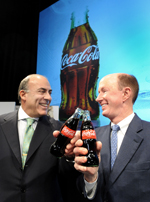Coca-Cola Company buys major bottler
If The Coca-Cola Company’s executives were politicians, they would now be awarded the title “flip-floppers”. Because if you look at the deal more closely, it represents nothing less than a total about-face on corporate dogma. It had been Roberto Goizueta, CEO of Coca-Cola Company between 1980 and 1997 who decided over twenty years ago to cut the number of bottlers to a few anchor bottlers so that CCC could focus on brand building.
Readers may remember that in the 1980s CCC bought several of its U.S. bottlers that weren’t performing well and combined them with its own bottling network, calling the new outfit Coca-Cola Enterprises (CCE) in 1986. Then it spun CCE off to the public but kept 49 percent of the stock and the right to boss CCE about. At the same time, CCC washed billions of dollars in debt and a low-return, capital-hungry business off its books.
For nearly 25 years, Coca-Cola benefited from having effective control of its largest bottlers, while not having to consolidate these low-return, capital-demanding businesses onto its balance sheet. CCC’s investors willingly bought into this new anchor bottler dogma, basking in the glow of earnings growth.
Of course, there is a reason why in 2010 CCC decided to ditch religion: PepsiCo, its biggest U.S. rival, has done the same. Last April, PepsiCo bought two of its U.S. bottlers in a deal worth USD 6.4 billion (EUR 4.7 billion). The rationale was to simplify its manufacturing and distribution system in its home market.
The recent CCC-CCE deal will give CCC direct control of 75 percent of its total U.S. bottling and distribution business.
Muhtar Kent, CCC’s Chief Executive, said the deal was an evolution of its relationship with its bottling organisation in the U.S., and denied allegations that it was an about-face.
Mr Kent stressed that Coke remained committed to its franchise model of having separate bottling and distribution operations elsewhere in the world and that the deal reflected the unique characteristics of the U.S. market.
"Our U.S. business has a very different footprint from the businesses we have across the rest of the world," Mr Kent was reported as saying.
These include the current separation of the company-run U.S. soda fountain business with the marketing and distribution of bottled drinks. In the U.S., CCC also manufactures its juices and water drinks; CCE and other bottlers manufacture the bottled sodas but distribute all the drinks in their U.S. territories.
Elsewhere in the world, all Coke beverages are produced by bottling partners such as Coca-Cola Amatil in Asia and eastern Europe, and Coca-Cola FEMSA in Latin America.
Mr Kent said the deal would also enhance Coke’s ability to service big retail customers such as Walmart, which have been pushing for the company to start delivering some products via its distribution centres rather than use the traditional direct-to-store model.
Many analysts remain wary: For CCC taking on CCE means that North American revenue will account for 50 percent of CCC’s total revenue at time when the U.S. is struggling with a weak economy.
CCE, meanwhile, will retain the Coca-Cola Enterprises Inc. corporate name and remain headquartered in Atlanta. CCE will continue to be traded on the NYSE. John Brock, Chairman and Chief Executive Officer, Bill Douglas, Chief Financial Officer, Hubert Patricot, President of the European Group, and other members of the CCE corporate management team will continue to lead the company.
The deal will see CCE take over Coke’s company-owned bottling operations in Norway and Sweden, and eventually in Germany.
Hopefully CCE’s boss John Brock (ex-CEO of InBev) knows what he is doing.
In Germany in 2008, CCC’s local bottling and distribution outfit, CCEAG, sold 35 million hl of beverages and employed some 12,000 people. That number is going to be halved, according to reports by Inside, a German trade publication, as CCEAG had to report a loss of about EUR 90 million in its 2008 accounts back to Atlanta.
Employees working in logistics will be affected most by the job cuts. Direct distribution, or what CCEAG calls “availability at arm’s length”, is becoming more and more costly.
Expect some massive labour disputes this month. CCEAG’s labour agreement will expire on 31 March 2010.


